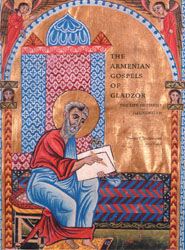Barlow Der Mugrdechian
Advisor
The Armenian Gospels of Gladzor: The Life of Christ Illuminated. Thomas F. Mathews and Alice Taylor (Los Angeles: J. Paul Getty Museum, 2001) 51 pp. + 60 color plates.
 In commemoration of the 1700th anniversary of the proclamation of Christianity as the State Religion of Armenia, the J. Paul Getty Museum of Los Angeles has published a lavishly produced and handsome monograph, The Armenian Gospels of Gladzor, devoted to the study of a single manuscript.
In commemoration of the 1700th anniversary of the proclamation of Christianity as the State Religion of Armenia, the J. Paul Getty Museum of Los Angeles has published a lavishly produced and handsome monograph, The Armenian Gospels of Gladzor, devoted to the study of a single manuscript.
The book was published in conjunction with The Armenian Gospels of Gladzor, an exhibition devoted to this rare Gospel book on loan from the Department of Special Collections of the Charles E. Young Research Library at UCLA. Accompanying the exhibition was a series of related public programs including lectures, gallery talks, and concerts.
On exhibition September 11 through December 2, 2001, this masterpiece of 14th-century Armethe manuscript, includes dozens of brilliantly colored miniatures illustrating the life of Christ. In four chapters, art historians and authors Thomas F. Mathews and Alice Taylor bring to life the Gospels produced at the Armenian monastery of Gladzor, sometime at the beginning of the 14th century.
In Chapter One, Making an Illuminated Manuscript, the place of illuminated manuscripts in Armenian culture is discussed. The authors outline how the Armenians developed their own Christian tradition in theology, which was eventually expressed through painting. Through the narrative miniatures, Armenians expressed the important scenes from the Life of Christ. A thorough discussion of the making of the manuscripts, along with comments about the artists involved form the core of the first chapter.
Chapter Two, Armenian under the Mongols, brings to life the historical context from which the Gladzor Gospels arose. Armenians in the late 13th and early 14th centuries were influenced by not only the Armenian Kingdom of Cilicia, but by the rule of the Mongols and the Georgians.
The arrival of the Mongols, in the first quarter of the thirteenth century, constituted a new cultural influence on the Armenians. Although the Mongols’ early invasions caused much destruction, eventually the Armenians prospered under a relative degree of tolerance. Armenian education and exploration of theological issues continued in the monasteries and production of manuscripts also continued.
Chapter Three, The Life of Christ in Miniature, concentrates on an understanding of the Armenian artistic approach to the illumination of manuscripts. The authors of this monograph provide a detailed analysis of the specifically Armenian approach to this artistic expression. To do this, they had to elucidate not only the existing Armenian tradition of Armenian painting, but also explore the Armenian exegetical sources.
This dual line of inquiry leads to several important conclusions about the Gladzor Gospels. The main artist of the Gospel, Toros of Taron, worked along with his abbot, Yesayi Nchetsi, both of them constantly discussing and developing an Armenian approach to both art and theology.
One sub-section of this chapter, The Human and the Divine in Christ, explains both the theology of the Armenian Church and also how that theology was expressed in the paintings. Another sub-section, Women in the Life of Christ, describes the importance of women in the Gladzor Gospels-twenty-one of the fifty-six miniatures involve women.
Chapter Four, the Conclusion, summarizes the theological discussions that must have accompanied the production of the manuscript. The authors also discuss the models on which many of the Gladzor paintings are based, such as the Vehapar Gospel, which itself was an example of Armenian Gospels representing a tradition before the advent of both the Mongols and Roman Catholic missionaries.
The conclusion of the Chapter details the fascinating provenance of the Gladzor Gospels as it exchanged hands numerous times. In 1377, the Gladzor Gospels came into the possession of an Armenian princess who treasured it and wrote a prayer in it. Over the course of the following centuries, the manuscript traveled across Asia before coming to UCLA in 1968 as a donation from Dr. Caro Minasian, a physician from New Julfa.
This extremely readable and beautiful book is a valuable addition to the growing body of scholarly work on Armenian manuscript illumination. Thomas F. Mathews and Alice Taylor have contributed much to the discussion of Armenian manuscripts by their detailed study of the Gladzor Gospels. Both scholars and non-scholars will find this monograph to be a much treasured part of their library.
 Hye Sharzhoom Armenian Action
Hye Sharzhoom Armenian Action